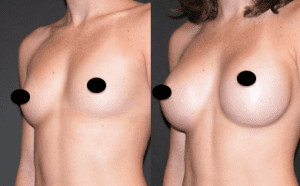
Actual Patient
What are the Different Types of Breast Implants?
When it comes to selecting a breast implant, American women have more choices now than ever before. Between the different shapes, materials, and profiles of implants, it can sometimes become a little overwhelming in trying to figure out what might work best for your own particular goals.
In this section, we’ll review the options, and their advantages and drawbacks, to help you prepare for your consultation.
1. Traditional silicone gel-filled implants
These are a very popular option with our patients. The main reason is the “feel” of the implant – it feels very natural, as silicone gel is a good mimic for the feel of natural breast tissue. It also has the advantage of a low “ripple rate” – when the implant folds can be felt through the skin – so this is an advantage for women who are very slender. Also, there are a wide variety of shapes and sizes available from FDA-approved manufacturers.
Disadvantages: it is a little more expensive compared to a traditional saline implant. It is not adjustable in size, as it is pre-filled at the implant factory. Follow-up imaging of the breast, with either ultrasound or MRI, is recommended by the FDA to periodically check on the status of the implants. It is often most convenient to do ultrasound imaging of the breast at the same time as a mammogram appointment.
2. “Gummy Bear” (cohesive) silicone implants
This is a new generation of high-tech silicone gel implants that has rapidly been growing in terms of popularity. Although the term “gummy bear” is widely used, the correct name for this implant is a “form-stable cohesive gel implant” or “generation 5 implant”. The gel on the inside is still made of silicone, but it is formulated in a way that is thicker and semi-solid. (Think of “Jell-O” or a marshmallow, rather than honey.) As a result, should the implant develop a tear in the outer shell, the thick gel on the inside does not migrate or spread out, giving the gummy bear implant more of a leak-resistant nature. The ripple rate is said to be very low.
The cost of the round “Inspira Cohesive” implants from Allergan is a little higher than the standard silicone gel implants. These implants are just slightly firmer in their feel, compared to the traditional silicone implants, and get good reviews from our patients.
Dr. Fiala prefers these cohesive implants for women who are very slender, for those with ripple problems, and for those patients who prefer a little more fullness in the upper part of the breast.
3. Traditional Saline implants
Saline implants have the advantage of being the least expensive implant and being adjustable by the surgeon at the time of the procedure, which may be especially helpful for women with major breast asymmetry. They can work very well in women who have good coverage of the implant, with about one inch of tissue thickness over the implant. In women who are slender, however, ripples and wrinkles from the implant can sometimes be seen or felt through the thin tissue. This occurs in about 10% of patients overall and is most common in saline implants that were placed in the sub-glandular position (“over the muscle”). Sub-pectoral positioning can reduce rippling in the cleavage area, but may not help with ripples in the outer-lower part of the breast.
Saline implants do not require follow-up MRIs or ultrasounds, so they are a reasonable “low-maintenance” choice. It’s easy to tell if they ever deflate. Since they are adjustable at the time of surgery, we can customize the fill to the patient’s desires.
4. Structured Saline implants
As of May 2023, the IDEAL multi-chambered saline implant is no longer available. We are sorry to see them leave the marketplace, as their saline implant design was innovative and had a excellent feel.
Implant manufacturers
In the USA, there are currently three FDA-approved companies that manufacture and sell breast implants: Allergan, Mentor, and Sientra. Not all companies sell all types of devices.
After years of working with all the companies’ implants, we feel that they all are high-quality devices. There are, however, subtle differences in the sizes and shapes that each company makes, and subtle differences in the manufacturing methods.
Each company has its own trade name for its products. Mentor, for example, uses the term “MemoryGel” to refer to the silicone gel in its traditional gel implants. Allergan calls their implants by the “Natrelle” trademark, while their newer implants also get the “Inspira” designation. Don’t get bogged down with these marketing terms – we will answer any questions you may have about this during your consultation.
All three companies have warranties on the implants against leakage. These programs are quite similar between the companies.
